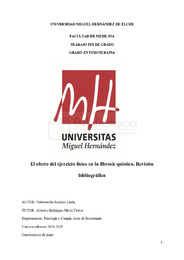Please use this identifier to cite or link to this item:
https://hdl.handle.net/11000/37614Full metadata record
| DC Field | Value | Language |
|---|---|---|
| dc.contributor.advisor | Álvarez Rodríguez, María Teresa | - |
| dc.contributor.author | Torremocha Jiménez, Lucía | - |
| dc.contributor.other | Departamentos de la UMH::Patología y Cirugía | es_ES |
| dc.date.accessioned | 2025-10-03T06:57:28Z | - |
| dc.date.available | 2025-10-03T06:57:28Z | - |
| dc.date.created | 2025-05-17 | - |
| dc.identifier.uri | https://hdl.handle.net/11000/37614 | - |
| dc.description.abstract | Introducción: La fibrosis quística es una enfermedad genética, crónica y multisistémica que afecta entre otras a los pulmones. Esto puede comprometer gravemente la calidad y la esperanza de vida de los pacientes. Durante años el tratamiento fisioterapéutico se ha enfocado en el drenaje de secreciones y el control de las exacerbaciones e infecciones pulmonares. Sin embargo, en los últimos años, se ha implementado el ejercicio físico como parte del tratamiento. Objetivo: Analizar la eficacia del ejercicio en la mejora de la condición clínica y funcional de los pacientes con fibrosis quística. Material y métodos: Se realizó una búsqueda en las bases de datos Pubmed, PEDro, Cochrane, Cuiden y Enfispo, seleccionando un total de once ensayos clínicos aleatorizados publicados entre 2015 y 2025. Con una calidad metodológica en la escala PEDro igual o mayor a seis. Resultados: Los resultados mostraron mejoras en la capacidad del ejercicio, en la fuerza muscular, en ciertos parámetros de la función pulmonar y en las características del moco. No se encontraron resultados claros en la mejora de la calidad de vida y en parámetros como el FEV1 y FVC. Se vio que la adherencia no fue óptima. Conclusión: El ejercicio físico es una intervención beneficiosa para pacientes con fibrosis quística, aunque no ha quedado claro con respecto a ciertos valores de la función pulmonar y en la calidad de vida. | es_ES |
| dc.description.abstract | Introduction: Cystic fibrosis is a genetic, chronic, multisystem disease that affects the lungs, among other things. This can severely compromise the quality of life and life expectancy of patients. For years, physiotherapeutic treatment has focused on drainage of secretions and control of pulmonary exacerbations and infections. However, in recent years, physical exercise has been implemented as part of the treatment. Objective: To analyze the effectiveness of exercise in improving the clinical and functional condition of patients with cystic fibrosis. Methods: A search was conducted in the PubMed, PEDro, Cochrane, Cuiden, and Enfispo databases, selecting a total of eleven randomized clinical trials published between 2015 and 2025. All trials had a methodological quality score of six or greater on the PEDro scale. Results: The results showed improvements in exercise capacity, muscle strength, certain parameters of lung function and mucus characteristics. No clear results were found in the improvement of quality of life and parameters such as FEV1 and FVC. Adherence was not optimal. Conclusion: Physical exercise is a beneficial intervention for patients with cystic fibrosis, although its effects on certain lung functions and quality of life measures remain unclear. | es_ES |
| dc.format | application/pdf | es_ES |
| dc.format.extent | 65 | es_ES |
| dc.language.iso | spa | es_ES |
| dc.publisher | Universidad Miguel Hernández | es_ES |
| dc.rights | info:eu-repo/semantics/openAccess | es_ES |
| dc.rights | Attribution-NonCommercial-NoDerivatives 4.0 Internacional | * |
| dc.rights.uri | http://creativecommons.org/licenses/by-nc-nd/4.0/ | * |
| dc.subject | Cystic fibrosis | es_ES |
| dc.subject | Exercise | es_ES |
| dc.subject | Physical activity | es_ES |
| dc.subject.other | CDU::6 - Ciencias aplicadas | es_ES |
| dc.title | El efecto del ejercicio físico en la fibrosis quística. Revisión bibliográfica. | es_ES |
| dc.type | info:eu-repo/semantics/bachelorThesis | es_ES |

View/Open:
TFG TORREMOCHA JIMÉNEZ LUCÍA.pdf
899,48 kB
Adobe PDF
Share:
.png)
